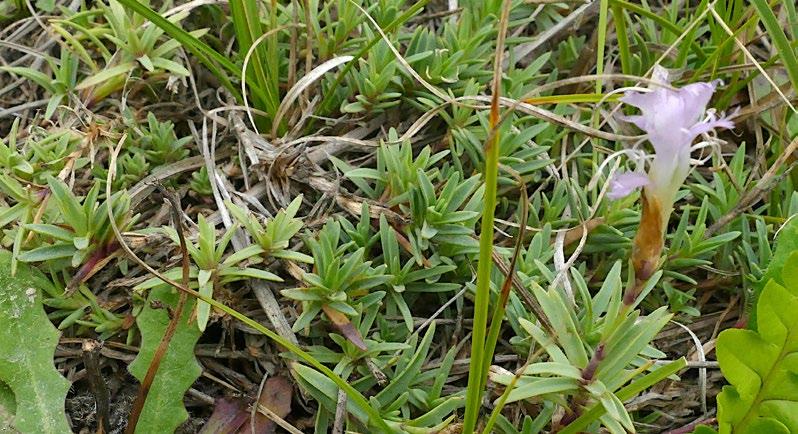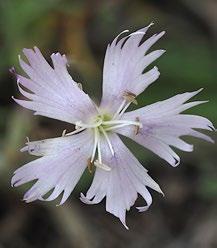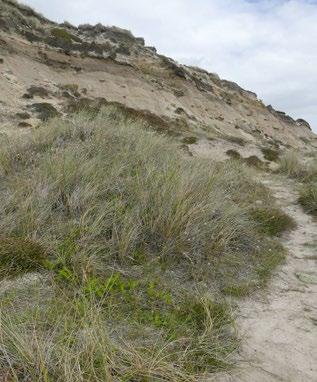
6 minute read
from mainland UK Phil Collier, Robin Garnett Martin Rand
Dianthus gallicus (Jersey Pink) newly recorded from mainland UK
PHIL COLLIER, ROBIN GARNETT & MARTIN RAND
Advertisement
The dunes on the south side of Hengistbury Head (South Hampshire, v.c.11) are unusually extensive (for Hampshire!) and relatively remote compared with nearby coastal areas. Several plant species are common here while generally scarce elsewhere, including Calystegia soldanella (Sea Bindweed), Euphorbia paralias (Sea Spurge) and Jasione montana (Sheep’s-bit).
During a visit to the dunes on 8 September 2020, two of us (PC and RG) lingered to discuss the ID of Jasione montana. One of us glimpsed a Dianthus flower, only for a subconscious mind to immediately correct this ‘mistake’: ‘it’s only Silene uniflora’. Vegetatively this was not a bad call, but the conscious mind played its trump card again: ‘that is a Dianthus flower’. Of course, we lingered much longer now. We could find only a few plants and a couple of rain drenched flowers. But there was enough material to suggest strongly that this was a small population of D. gallicus.
Given such a mouth-watering discovery, it took only a day for the third author (MR) to arrive on the scene, and later confirm from various sources that this was indeed the first record for v.c.11 (South Hampshire) and mainland UK of D. gallicus, and not a different species or horticultural look-alike.
Stand of Dianthus gallicus (Jersey Pink) at Hengistbury Head, September 2020. Martin Rand
Known distribution and history
Dianthus gallicus Pers. (Jersey Pink) is a dune species of the Atlantic seaboard of France and Spain. Scattered records elsewhere in France and Europe are shown on the Global Biodiversity Information Forum (GBIF) website; but curiously, the mapping on the French national SI Observation Flore site shows it over much of the Pyrenean chain and northwards into the Massif Central. This is presumably because some recorders conflate it with D. hyssopifolius L. in part of the latter’s range. Many authors, including Castroviejo et al. (1990) in Spain, treat it as a subspecies of D. hyssopifolius, but the ecology of the two is distinct in much of their range. Visible differences are few: shorter, more glaucous leaves and shorter epicalyx bracts in D. gallicus. Some authors mention depth of cutting of the petals but

Dianthus gallicus flower, October 2020.Tristan Norton
there is overlap; horticultural D. hyssopifolius seems to be selected for frilliness. Although the habitat of D. hyssopifolius over much of its range is upland grassland and glades, both occur in fixed dunes in northern Spain, where intermediates are said to be the commonest plants (Aizpuru et al., 2007). The north-eastern limit of D. gallicus is the western Cotentin peninsula in Basse-Normandie, where it was not recorded in the 19th-century Flora of the area (Corbière, 1893); it was not noted there until 1930 (Provost, 1993). From here it extends south and west to Galicia in Spain, but with few reliable records beyond Cantabria.
French botanists consider D. gallicus a recent introduction to Basse-Normandie, where it is now known in several more sites and is thought to be expanding its range (Zambettakis & Provost, 2009). Nonetheless, it is on the French Red List as ‘Near Threatened’ and has national statutory protection. It is surprisingly rare in some parts of its range; for instance, in the spectacularly dune-laden Gironde of SW France, it is known in only a few sites and in small numbers (Aniotsbehere, 2005).
The first British record was in 1892 on Jersey. Stace (2019) describes the Jersey population as ‘naturalised’, and the habitat as ‘grassy coastal dunes’. The most recent record was in 2019, when the species was noted as ‘rare’ in its habitat. Anne Haden (pers. comm.) reports that seedlings are not found here. There is a good account of its chequered history in the States of Jersey Biodiversity (Jersey Pink) Action Plan (undated, post-2011), available on the internet.
Habitat in Hampshire
A groyne was constructed at the Head in 1938, which intercepts the long-shore drift. Aerial photographs taken by Cambridge University in 1949 show a broad sandy strand and a vestigial foredune under the cliff at Hengistbury Head. There is now a well-developed mobile foredune backed by semistabilised dune vegetation dominated by Ammophila arenaria (Marram). This grades to the north into an open Calluna heath established on the talus from the soft sandstone cliffs above, and to the east into areas of seasonally damp sandy flat.
The vegetation in the limited area where the Dianthus occurs is probably best characterised as Ammophiletum arenariae on a transition between a National Vegetation Classification SD6 mobile dune community and an SD7 semi-fixed community (Rodwell, 2000), albeit with little in the way of perennial grasses. There is an extensive ground

Habitat of Dianthus gallicus habitat at Hengistbury Head, with Ammophila arenaria (Marram) and Polypodium interjectum (Intermediate Polypody) in foreground, September 2020. Martin Rand
cover of Cladonia lichens in more open places, and in early November we were struck by the luxuriance of these mats, which shrouded much of the basal growth of the Dianthus with their podetia.
MR has recorded the following vascular plant species in the immediate neighbourhood of the Dianthus patches: • Naturalisation of a garden plant. D. gallicus is listed in the European Garden Flora (2011), and on the RHS and a few other UK gardening websites. However, it is not easy to find plants for sale in the UK. D. hyssopifolius is sold by a few nurseries (often under the older name
D.monspessulanus), but available evidence suggests these are the type species. The main area of dune at Hengistbury is a spit beyond the Head which is heavily ‘urbanised’ with beach huts, but we have not found any plants in this area. • Seed introduced with sand that has been replenished artificially from time to time since the mid-1970s to maintain the tourist beaches in the area. Sand for this purpose has been brought from the Isle of Wight and from Poole
Harbour, but more recently it has been sourced from local offshore dredging.
Unfortunately, asking how or why about such an isolated plant distribution anomaly seldom yields a convincing answer; nevertheless, D. gallicus is an exciting and attractive addition to the flora of Hampshire.
Ammophila arenaria (Marram) Locally dominant Calluna vulgaris (Heather) Occasional Calystegia soldanella (Sea Bindweed) Rare Carex arenaria (Sand Sedge) Locally frequent Erigeron canadensis (Canadian Fleabane) Rare Hieracium umbellatum (Umbellate Hawkweed) Rare Hypochaeris radicata (Cat’s-ear) Frequent Jasione montana (Sheep’s-bit) Occasional Lagurus ovatus (Hare’s-tail) Frequent Polypodium interjectum (Intermediate Polypody) Locally frequent Silene uniflora (Sea Campion) Occasional (seedlings)
Population in Hampshire
The D. gallicus plants in Hampshire are prostrate and mat-forming, with short erect-ascending flower stems. The four known large plants/patches are easily overlooked in their habitat, despite several visitors recording a few flowers since early September. It is possible that the true extent of the population will become more obvious if there is a spring/summer flush of flowering, as the numerous dead heads suggest.
Native or naturalised?
There remains an obvious question: how did D. gallicus plants find themselves in Hampshire? For the species to be long native to the area would require a pre-1930 dune system. A more recent natural introduction of seed by water or bird transport seems implausible, although consistent with its northward spread in France. Apart from a deliberate planting, for which there is no current evidence, other possible means of an introduction include:
References
Aizpuru, I. et al., 2007. Claves Ilustradas de la Flora del País
Vasco, Eusko Jaurlaritzaren Argitalpen Zerbitzu Nagusia,
Vitoria-Gasteiz. Aniotsbehere, J-C. 2005. Flore de Gironde. Société Linnéenne de Bordeaux, Bordeaux. Castroviejo, S. et al. (ed), 1990. Flora Iberica vol. 2, Real Jardín
Botánico, Madrid. Corbière, L., 1893. Nouvelle Flore de Normandie, E. Lanier, Caen. Provost, M., 1993, Atlas de répartition des plantes vasculaires de
Basse-Normandie, Presses Universitaires de Caen, Caen. Rodwell, J.S. (ed.) (2000). British plant communities. Volume 5.
Maritime communities and vegetation of open habitats. Cambridge
University Press, Cambridge. Stace, C.A. 2019. New Flora of the British Isles (4th edn).
C & M Floristics, Middlewood Green, Suffolk. Zambettakis, C. & Provost, M., 2009. Flore rare et menacée de
Basse-Normandie, in Quarto, Condé-sur-Noireau.









